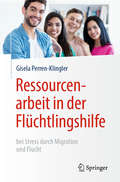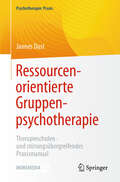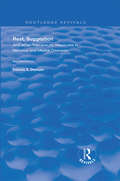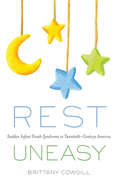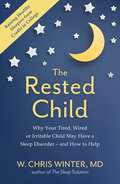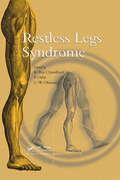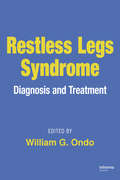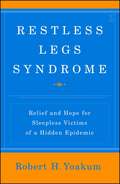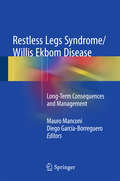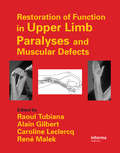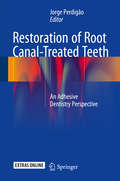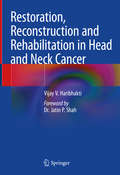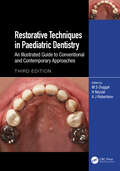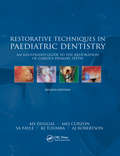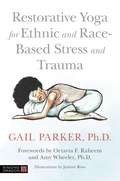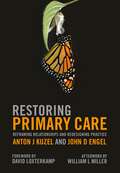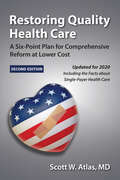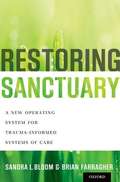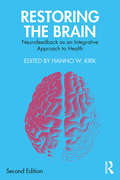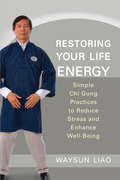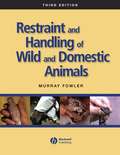- Table View
- List View
Ressourcenarbeit in der Flüchtlingshilfe: bei Stress durch Migration und Flucht
by Gisela Perren-KlinglerErzwungene Migration und Flucht bedeuten oft eine große Verunsicherung oder sogar Traumatisierung der Betroffenen. Nach Ankunft im Gastland gilt es, die disruptiven Erfahrungen zu bewältigen, um eine gute Integration und möglichst selbständiges Leben aufbauen oder nach Rückkehr ins Heimatland an das frühere Leben anknüpfen zu können. Die hier dargestellten Vorgehensweisen basieren auf der Grundannahme, dass Menschen über ausreichende Ressourcen verfügen, um auch nach potenziell traumatischen Erlebnissen gut weiterzuleben und zu wachsen; es gilt, diese spezifischen Ressourcen wiederzuentdecken, zu nutzen und zu stärken. Das Buch bietet einfach aufbereitetes Grundlagenwissen rund um die Themen exzessiver Stress und seine Konsequenzen, Trauma und Verlusterlebnisse. Zahlreiche einfache Strategien und Techniken werden aufgezeigt, wie betroffene Menschen unter Anleitung Ressourcen aktivieren können, um diese Herausforderungen zu meistern. Das Buch richtet sich an alle Berufsgruppen, die im psychosozialen Dienst in der Flüchtlingshilfe aktiv sind. Es kann sogar dazu benützt werden, um mit Flüchtlingen zusammen eine Ausbildung als Mediatoren und Mediatorinnen für ihre Landsleute in die Wege zu leiten.
Ressourcenorientierte Gruppenpsychotherapie: Therapieschulen- und störungsübergreifendes Praxismanual (Psychotherapie: Praxis)
by Jannes DustDieses Buch soll Ihnen im Rahmen einer Kompetenzorientierung alles an die Hand geben, was Sie für die Leitung einer ressourcenorientierten Gruppenpsychotherapie in der ambulanten und/oder stationären Behandlung brauchen. Anhand von konkreten Praxisanleitungen, zahlreichen Beispielen und übersichtlichem Arbeitsmaterial unterstützt Sie dieses Manual von der Vorbereitung über die Durchführung bis zur letzten Gruppensitzung. Es soll Ihnen Unsicherheiten nehmen, Sie auf schwierige Situationen in der Gruppe vorbereiten und Sie in der Findung Ihrer therapeutischen Haltung stärken. Aus dem Inhalt: Selbstheilungskräfte – Selbstfürsorge – Versorgung von Bedürfnissen – Ressourcenaktivierung – Selbstwertgefühl und Selbstwirksamkeit. Über den Autor:Jannes Dust, M.Sc. Psychologe, Psychologischer Psychotherapeut. Erfahrung in unterschiedlichen psychiatrischen Einrichtungen, mit Schwerpunkt Gruppenpsychotherapie. Niedergelassen in eigener Praxis in Bonn. Arbeitsschwerpunkte: Ressourcenorientierte Therapie, Gruppenpsychotherapie, Verhaltenstherapie, Strukturpathologie, Abhängigkeitserkrankungen und außergewöhnliche Erfahrungen.
Rest Is Resistance: A Manifesto
by Tricia Hersey***INSTANT NEW YORK TIMES BESTSELLER***Disrupt and push back against capitalism and white supremacy. In this book, Tricia Hersey, aka The Nap Bishop, encourages us to connect to the liberating power of rest, daydreaming, and naps as a foundation for healing and justice. What would it be like to live in a well-rested world? Far too many of us have claimed productivity as the cornerstone of success. Brainwashed by capitalism, we subject our bodies and minds to work at an unrealistic, damaging, and machine‑level pace –– feeding into the same engine that enslaved millions into brutal labor for its own relentless benefit. In Rest Is Resistance, Tricia Hersey, aka the Nap Bishop, casts an illuminating light on our troubled relationship with rest and how to imagine and dream our way to a future where rest is exalted. Our worth does not reside in how much we produce, especially not for a system that exploits and dehumanizes us. Rest, in its simplest form, becomes an act of resistance and a reclaiming of power because it asserts our most basic humanity. We are enough. The systems cannot have us.Rest Is Resistance is rooted in spiritual energy and centered in Black liberation, womanism, somatics, and Afrofuturism. With captivating storytelling and practical advice, all delivered in Hersey&’s lyrical voice and informed by her deep experience in theology, activism, and performance art, Rest Is Resistance is a call to action, a battle cry, a field guide, and a manifesto for all of us who are sleep deprived, searching for justice, and longing to be liberated from the oppressive grip of Grind Culture.
Rest, Suggestion, and Other Therapeutic Measures in Nervous and Mental Diseases (Routledge Revivals)
by Francis Xavier DercumFirst published in 1919. Emphasis has been laid upon simple physiologic methods of treatment; such as rest, feeding and psychotherapy. In order that the principles underlying the application of these methods should be clearly appreciated, the author has unfolded, in as systematic a manner as possible, the problems presented by the exercise of function, rest and the various fatigue states. He has adopted a purely clinical interpretation of the neuroses, a clear comprehension of which is an indispensable preliminary to intelligent and successful treatment. In embracing physiologic methods, medicines and psychotherapy in one volume, the author has endeavoured to present a comprehensive discussion of the treatment of nervous and metnal disorders; especially of those which are functional in character.
Rest Uneasy: Sudden Infant Death Syndrome in Twentieth-Century America (Critical Issues in Health and Medicine)
by Brittany CowgillTracing the Sudden Infant Death Syndrome (SIDS) diagnosis from its mid-century origins through the late 1900s, Rest Uneasy investigates the processes by which SIDS became both a discrete medical enigma and a source of social anxiety construed differently over time and according to varying perspectives. American medicine reinterpreted and reconceived of the problem of sudden infant death multiple times over the course of the twentieth century. Its various approaches linked sudden infant deaths to all kinds of different causes—biological, anatomical, environmental, and social. In the context of a nation increasingly skeptical, yet increasingly expectant, of medicine, Americans struggled to cope with the paradoxes of sudden infant death; they worked to admit their powerlessness to prevent SIDS even while they tried to overcome it. Brittany Cowgill chronicles and assesses Americans’ fraught but consequential efforts to explain and conquer SIDS, illuminating how and why SIDS has continued to cast a shadow over doctors and parents.
The Rested Child: Why Your Tired, Wired, or Irritable Child May Have a Sleep Disorder - and How to Help
by W. Christopher WinterSleep disorders in children are on the rise. Experts have pronounced sleeplessness a 'hidden health crisis' for young people, with 10 percent of children presenting with diagnosable sleep disorders - but well over half are misdiagnosed. Every year, tens of thousands of children are treated for diseases such as diabetes, learning disorders, or chronic pain, when the real root cause of their ailment may actually be a sleep disorder for which they're not being treated.In this ground-breaking guide, neurologist and sleep expert Dr Chris Winter identifies the signs and symptoms of the most common sleep disorders affecting children today, and he empowers parents and caregivers to understand the steps necessary to address and treat their children's sleep problems. From common issues such as too much screen time and night terrors, to narcolepsy, sleep apnoea, and more, The Rested Child leaves no stone unturned. This book pulls back the curtain on the relationship between poor sleep quality and paediatric epidemics related to psychiatric health, rising obesity, ADD/ADHD, pain disorders, and other undiagnosed disorders of sleepiness and fatigue.Finally parents have a resource to help them uncover the root of their children's problems, and, more important, to provide the answers on how to help.
Restless Legs Syndrome: Restless Legs Syndrome
by K. Ray Chaudhuri C. Warren Olanow Per OdinAlthough briefly covered in neurology texts, until now there has been no professional-level publication dedicated solely to restless legs syndrome (RLS). Most of what is available is either out-of-date or too general. Written by a panel of experts, Restless Legs Syndrome fills the void. Focusing on diagnosis and management, the authors discuss the
Restless Legs Syndrome: Diagnosis and Treatment
by William G. OndoThe most authoritative and comprehensive guide on RLS to date, this expertly written source examines the pathogenesis, diagnosis, and treatment of a condition affecting nearly 10% of the population. Ranging from basic science to therapeutics, Restless Legs Syndrome analyzes the many new and emerging medications impacting the management of this diso
Restless Legs Syndrome
by Robert YoakumWithin these pages is the promise of a long-awaited good night's rest. For decades, millions of people have experienced the irresistible urge to move their legs without understanding why. These disagreeable leg sensations get worse with inactivity, making sitting still and sleep painful and sometimes impossible. If you hold this book, you or someone you love has most likely lived with this constant discomfort, this agitated inability to rest -- restless legs syndrome. You are not alone. According to the American Medical Association, 10 to 15 percent of adult Americans have the neurological disorder known as restless legs syndrome. This underdiagnosed and treatable condition can completely overwhelm a person's life, causing stress, sleep deprivation, career difficulties, and relationship strife. Author Robert Yoakum has suffered from restless legs syndrome all of his adult life. In Restless Legs Syndrome, he has compiled a comprehensive resource on this disease, giving those afflicted with it a voice and creating a community. In addition, many of the foremost medical specialists in the field have contributed their knowledge and experience to make this the most comprehensive and timely source of information on this disease. Restless Legs Syndrome provides invaluable information for victims, their friends and loved ones, and health-care providers. Yoakum informs and advises readers on: Sleep management and alternative rest options How to enlist help from others Possible causes of restless legs syndrome Criteria for diagnosis Medical advice and treatment options The relationship of stress, dopamine, and iron Finding or creating a restless legs syndrome support group Yoakum combines empathy and understanding with practical, clear-cut information, and helpful stories from others who share their tales of relief and hope.
Restless Legs Syndrome/Willis Ekbom Disease
by Mauro Manconi Diego García-BorregueroDue to the fact that Restless Legs Syndrome/Willis-Ekbom Disease is usually a chronic condition, this book aims to provide physicians with the necessary tools for the long-term management of patients with RLS. The first part of the book addresses the various comorbidities and long-term consequences of RLS on life quality, sleep, cognitive, psychiatric and cardiovascular systems, while the second part focuses on the management of long-term treatment and the drug-induced complications in primary RLS and in special populations. Written by experts in the field, this practical resource offers a high-quality, long-term management of RLS for neurologists, sleep clinicians, pulmonologists and other healthcare professionals.
Restoration of Function in Upper Limb Paralyses and Muscular Defects
by Raoul Tubiana Alain Gilbert Caroline Leclercq René MalekRestoration of Functions in Upper Limb Paralyses and Muscular Defects provides the necessary information for the surgical management of muscular defects and neurobiological disorders of the upper extremity and details the restoration of essential functions in this area.This text examines:Upper extremity paralysis and muscular deficits Free muscle t
Restoration of Root Canal-Treated Teeth
by Jorge PerdigãoThis book offers a comprehensive and up-to-date overview of the restoration of teeth retained through root canal treatment, from the perspective of adhesive dentistry. The challenge of adhesion to root dentin is first explained and guidance provided on assessment of the restorability of endodontically treated teeth. The types of prefabricated passive post are then described in detail. The advantages and disadvantages of each type are outlined, with identification of the factors that influence post selection. Further topics include the ferrule effect, evidencebased clinical applications of fiber posts and new methods to lute fiber posts to the root canal without dentin adhesives. In addition, frequent myths are identified and dispelled. All aspects are illustrated with clinical and laboratory images, diagrams and high-resolution electron microscopy photographs.
Restoration, Reconstruction and Rehabilitation in Head and Neck Cancer
by Vijay V. HaribhaktiThis book offers a comprehensive set of principles that lead to ideal outcomes following treatment for Head and Neck Cancers, especially in those patients who need major reconstructive procedures. It goes beyond the scope of basic Head and Neck Cancer textbooks, or of reconstructive surgery texts, in that the essential focus is on optimal outcomes beyond fundamental evaluation and management. The book addresses a range of essential aspects: the chapters on Functional and Aesthetic considerations underscore crucial basics that should be understood by all surgeons, while other chapters relevant to all members of the Head and Neck team address Imaging, Robotics, Radiation Morbidities, Prosthetics and Quality of Life. Throughout the book, particular attention is given to high-quality photographs, flow diagrams and tables wherever possible, combined with crisp writing to achieve effective communication. The book is unique in the completeness of its approach: from the time of initial presentation, to the time patients resume their normal lives. Although written primarily for surgeons, its value extends to all members of the multi-disciplinary team managing Head and Neck Cancer patients today.
Restorative cities: urban design for mental health and wellbeing
by Jenny Roe Layla McCayOvercrowding, noise and air pollution, long commutes, and lack of daylight can take a huge toll on the mental well-being of city-dwellers. With mental healthcare services under increasing pressure, could a better approach to urban design and planning provide a solution? The restrictions faced by city residents around the world during the COVID-19 pandemic has brought home just how much urban design can affect our mental health – and created an imperative to seize this opportunity. Restorative Cities explores a new way of designing cities, one that places mental health and wellness at the forefront. Establishing a blueprint for urban design for mental health, it examines a range of strategies – from sensory architecture to place-making for creativity and community – and brings a genuinely evidence-based approach that will appeal to designers and planners, health practitioners and researchers alike - and provide compelling insights for anyone who cares about how our surroundings affect us. Written by a psychiatrist and public health specialist, and an environmental psychologist with extensive experience in architectural practice, this much-needed work will prompt debate and inspire built environment students and professionals to think more about the positive potential of their designs for mental well-being.
Restorative Just Culture in Practice: Implementation and Evaluation
by Sidney Dekker, Joseph Rafferty and Amanda OatesA restorative just culture has become a core aspiration for many organizations in healthcare and elsewhere. Whereas ‘just culture’ is the topic of some residual conceptual debate (e.g. retributive policies organized around rules, violations and consequences are ‘sold’ as just culture), the evidence base on, and business case for, restorative practice has been growing and is generating increasing, global interest. In the wake of an incident, restorative practices ask who are impacted, what their needs are and whose obligation it is to meet those needs. Restorative practices aim to involve participants from the entire community in the resolution and repair of harms. This book offers organization leaders and stakeholders a practical guide to the experiences of implementing and evaluating restorative practices and creating a sustainable just, restorative culture. It contains the perspectives from leaders, theoreticians, regulators, employees and patient representatives. To the best of our knowledge, there is no book on the market today that can function as a guide for the implementation and evaluation of a just and learning culture and restorative practices. This book is intended to fill this gap. This book will provide, among other topics, an overview of restorative just culture principles and practices; a balanced treatment of the various implementations and evaluations of just culture and restorative processes; a guide for leaders about what to stop, start, increase and decrease in their own organizations; and an attentive to philosophical and historical traditions and assumptions that underlie just culture and restorative approaches. The interest in ‘just culture’, not just in healthcare but also in other fields of safety-critical practice, has been steadily growing over the past decade. It is a trending area. In this, it has become clear that 20-year-old retributive models not only hinder the acceleration of performance and organizational improvement but have also in some cases become a blunt HR instrument, an expression of power over justice and a way to stifle honesty, reporting and learning. What is new in this, then, is the restorative angle on just culture, as it has been developed over the last few years and now is practised and applied to HR, suicide prevention, healthcare improvement, regulatory innovations and other areas.
Restorative Techniques in Paediatric Dentistry: An Illustrated Guide to Conventional and Contemporary Approaches
by M S Duggal H Nazzal A J RobertsonOne of the first books on the market to illustrate the various clinical techniques for restoration, this revised and updated new edition offers new material on treatment planning, local analgesia, biomaterials, biological and contemporary approaches, and aesthetic crowns. The book addresses the specific needs of the paediatric patient and helps the clinician manage the restoration with those needs in mind. As a classic volume, it is essential for every dentist working with children and adolescent patients.
Restorative Techniques in Paediatric Dentistry: An Illustrated Guide to the Restoration of Extensive Carious Primary Teeth
by M.S. Duggal M.E.J Cuzon S.A. Fayle K.J Toumba A.J. RobertsonThis was one of the first books on the market to illustrate the various clinical techniques for restoration, which is increasingly favored over extraction for primary teeth. A revised and updated edition of this successful text offers, in addition, new material on plastic restorations. Restorative Techniques addresses the specific needs of the pediatric patient, and it helps the clinician manage the restoration with those needs in mind. As a classic volume, it is essential for every dentist, particularly those who work with children and adolescents and particularly those who perform restorative dentistry.
Restorative Yoga for Ethnic and Race-Based Stress and Trauma: A Visual Introduction (Therapeutic Parenting Bks.)
by Gail ParkerPresenting ways in which Restorative Yoga can contribute to healing emotional wounds, this book invites yoga teachers, therapists and practitioners to consider the psychological impact of ethnic and race-based stress and trauma. It aids in the process of uncovering, examining, and healing one's own emotional wounds and offers insight into avoiding wounding or re-wounding others. The book describes how race-based traumatic stress differs from PTSD and why a more targeted approach to treatment is necessary, as well as what can trigger it. It also considers the implications of an increasingly racially and ethnically diverse and global yoga community, as well as the importance of creating conscious yoga communities of support and connection, where issues of race and ethnicity are discussed openly, non-defensively and constructively.By providing a therapeutic structure that assists those directly and indirectly impacted by ethnic and race-based stress and trauma, Restorative Yoga for Ethnic and Race-Based Stress and Trauma provides valuable tools for aiding in the processing of stressful experiences and in trauma recovery.
Restorative Yoga for Ethnic and Race-Based Stress and Trauma
by Gail ParkerPresenting ways in which Restorative Yoga can contribute to healing emotional wounds, this book invites yoga teachers, therapists and practitioners to consider the psychological impact of ethnic and race-based stress and trauma. It aids in the process of uncovering, examining, and healing one's own emotional wounds and offers insight into avoiding wounding or re-wounding others. The book describes how race-based traumatic stress differs from PTSD and why a more targeted approach to treatment is necessary, as well as what can trigger it. It also considers the implications of an increasingly racially and ethnically diverse and global yoga community, as well as the importance of creating conscious yoga communities of support and connection, where issues of race and ethnicity are discussed openly, non-defensively and constructively.By providing a therapeutic structure that assists those directly and indirectly impacted by ethnic and race-based stress and trauma, Restorative Yoga for Ethnic and Race-Based Stress and Trauma provides valuable tools for aiding in the processing of stressful experiences and in trauma recovery.(P)2021 Hodder & Stoughton Limited
Restoring Primary Care: Reframing Relationships and Redesigning Practice
by Anton J Kuzel John D EngelTo many practitioners, managers and patients, US primary care is in crisis. Primary care physicians are often overworked and undervalued, and both patients and care providers can feel locked into structures that lack compassion and are unfit for their intended purposes. Healthcare reforms aim to resolve the situation, but changes may take years to deliver and are contingent on numerous outside factors. What steps are within care providers' power to take now? This book lays out a course to deliver compassionate care, quality, and efficiency that - unlike many current patient-centred medical home initiatives in the US - does not require outside funding. After reflecting on avoidable problems and harms in primary care, the book offers stories of hope from innovative clinicians across the US before presenting ten practical, deliverable steps to lift primary care provision from 'poor' or 'mediocre' to 'great'. This book will be of interest to practicing family physicians and general internists, but will also be useful reading for health system leaders, healthcare insurance purchasers and insurance company executives.
Restoring Quality Health Care: A Six-Point Plan for Comprehensive Reform at Lower Cost
by Scott W. AtlasThe Affordable Care Act (ACA) granted the federal government unprecedented regulatory authority over health insurance and the health care industry. Those changes ignore the fundamental problems with the existing system: the incentives that have caused runaway costs and excluded millions of Americans from accessing the world's best medical care. Many former ACA supporters now push for an even more extreme takeover of the US system: overt single-payer health care, or “Medicare for All.”In Restoring Quality Health Care, Dr. Scott W. Atlas offers a fundamentally different approach to improving America's health care system. Instead of framing the debate with the traditional trade-offs—fewer benefits versus higher taxes—his plan is modeled around a new paradigm: restoring the appropriate market-based incentives to increase the quality of health care and reduce its costs. He proposes a six-point reform plan for US health care centering on lower-cost catastrophic coverage and universal, significantly expanded health savings accounts (HSAs). The plan transforms the US health care system and enhances innovation by instilling market-based competition and empowering consumers through incentives and strategic deregulation. Most important, the health care reforms in this plan reflect the key principles held by Americans concerning what they value and expect from health care in terms of access, choice, and quality.
Restoring Sanctuary: A New Operating System for Trauma-Informed Systems of Care
by Sandra L. Bloom Brian FarragherThis is the third in a trilogy of books that chronicle the revolutionary changes in our mental health and human service delivery systems that have conspired to disempower staff and hinder client recovery. Creating Sanctuary documented the evolution of The Sanctuary Model therapeutic approach as an antidote to the personal and social trauma that clients bring to child welfare agencies, psychiatric hospitals, and residential facilities. Destroying Sanctuary details the destructive role of organizational trauma in the nation's systems of care. Restoring Sanctuary is a user-friendly manual for organizational change that addresses the deep roots of toxic stress and illustrates how to transform a dysfunctional human service system into a safe, secure, trauma-informed environment.
Restoring the Brain: Neurofeedback as an Integrative Approach to Health
by Hanno W. KirkThis thoroughly updated second edition of Restoring the Brain is the definitive book on the theory and the practice of Infra-Low Frequency brain training. It provides a comprehensive look at the process of neurofeedback within the emerging field of neuromodulation and essential knowledge of functional neuroanatomy and neural dynamics to successfully restore brain function. Integrating the latest research, this thoroughly revised edition focuses on current innovations in mechanisms-based training that are scalable and can be deployed at any stage of human development. Included in this edition are new chapters on clinical data and case studies for new applications; using neurofeedback for early childhood developmental disorders; integrating neurofeedback with psychotherapy; the impact of low-frequency neurofeedback on depression; the issue of trauma from war or abuse; and physical damage to the brain. Practitioners and researchers in psychiatry, medicine, and behavioral health will gain a wealth of knowledge and tools for effectively using neurofeedback to recover and enhance the functional competence of the brain.
Restoring Your Life Energy: Simple Chi Gung Practices to Reduce Stress and Enhance Well-Being
by Waysun LiaoIn our busy lives we are bombarded by energy that taxes us and depletes our chi. This book of simple movements and meditations drawn from the Chinese arts of t'ai chi and chi gung will help restore your life energy, known as chi. Chi, according to traditional Chinese medicine, is the fuel and essence that connects body, mind, and spirit, and without it we fall apart physically, mentally, and spiritually. In Restoring Your Life Energy, well-known and respected t'ai chi master Waysun Liao explains why protecting our chi is so important, how chi gets taxed and damaged in our lives, and how to restore it. He explains: * The three levels of healing--physical, mental, and energetic/spiritual: what they are, why it is important to understand them, and how to target our practice to address each level; * Moving meditation, a powerful way of restoring chi (once we learn to sense the flow of chi, we can actually direct healing chi energy to areas in our body that need attention); * And how to integrate our knowledge of chi with conventional advice regarding diet, exercise, and medication. The book includes numerous exercises including "exercises for daily life," simple breathing and sensory meditations that can be done throughout the day; more advanced breathing and sensory meditations; standing exercises to move internal energy; "cleansing forms" to do during times of stress; and deeply cleansing and restorative "Tao gong" exercises.
Restraint and Handling of Wild and Domestic Animals
by Murray FowlerRestraint and Handling of Wild and Domestic Animals, Third Edition offers an introduction to the basic principles of animal restraint and an overview of techniques for vertebrate wild and domestic animals. Fully updated throughout, the third edition also includes new chapters on understanding behavior, training for restraint and handling, and animal welfare and restraint. Now in full color, the third edition of this classic reference is an invaluable tool to recognizing potential danger in restraint and reducing stress in the animal.
